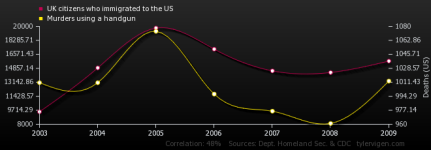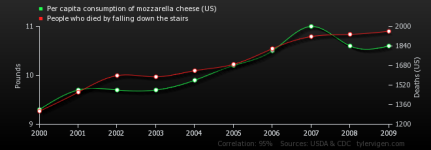maxparrish
Veteran Member
- Joined
- Aug 30, 2005
- Messages
- 2,262
- Location
- SF Bay Area
- Basic Beliefs
- Libertarian-Conservative, Agnostic.
Except those agencies cover most of the population:
Looks like whoever does not participate must be nit-picking small irrelevances.In 2007, law enforcement agencies active in the UCR Program represented more than 285 million United States inhabitants—94.6 percent of the total population.
http://www.fbi.gov/about-us/cjis/ucr/frequently-asked-questions/ucr_faqs
Here's what the UCR tracks:
The UCR Program collects offense information for murder and nonnegligent manslaughter, forcible rape, robbery, aggravated assault, burglary, larceny-theft, motor vehicle theft, and arson. These are Part I offenses and are serious crimes by nature and/or volume. Not all crimes, such as embezzlement, are readily brought to the attention of the police. Also, some serious crimes, such as kidnapping, occur infrequently. Therefore, the UCR Program limits the reporting of offenses known to the eight selected crime classifications because they are the crimes most likely to be reported and most likely to occur with sufficient frequency to provide an adequate basis for comparison.
This caveat is also specifically spelled out and bolded on the UCR page you linked (I underlined and italicized what I thought were other important parts):
Each year when Crime in the United States is published, some entities use reported figures to compile rankings of cities and counties. These rough rankings provide no insight into the numerous variables that mold crime in a particular town, city, county, state, or region. Consequently, they lead to simplistic and/or incomplete analyses that often create misleading perceptions adversely affecting communities and their residents. Valid assessments are possible only with careful study and analysis of the range of unique conditions affecting each local law enforcement jurisdiction. The data user is, therefore, cautioned against comparing statistical data of individual reporting units from cities, metropolitan areas, states, or colleges or universities solely on the basis of their population coverage or student enrollment. “Variables Affecting Crime” in Crime in the United States has more information on this topic.
And yet people wanting to blame black people for the amount of police violence visited upon them freely use this incomplete analysis to blame an entire demographic of people.
Whoops, I meant to add in this section that the UCR doesn't track the amount of times police officers shoot people so why should we expect any relevant information on how often and why police officers resort to deadly force in the UCR. So it doesn't surprise me that the UCR gets way more voluntary responses than the ARD does.
No one need "blame" people for being black, nor more than one should "blame" the innocent young black male for the unfortunate fact that so many of his racial and age group peers are disproportionately criminally prone. The fact remains, however, more blacks will have more run-ins with the law because more of them (proportionally) commit crimes of violence. And being "profiled" for being in the wrong place at the wrong time is a natural consequence and necessary.
Lets just look at the facts we DO (and don't) know:
1. UCR covers 95% of the population. Of those "between 85% and 90% of all homicides reported in the UCR summary data also have a corresponding SHR form." The SHR form is the one that provides information on total number of (police) justifiable homicides, and racial breakdowns. It is unclear what percentage of the covered population, are not covered for justifiable homicides and racial breakdowns for those homicides.
2. The three official sources of data provide similar consistent results. The FBI UCR, the CDC NVSS (based on death certificates), and the DOJ Statistics report around 400 to 450 police homicides per year. http://www.motherjones.com/politics/2014/08/police-shootings-ferguson-race-data
3. A separate study using a different methodology, the NVDRS states (16 of them), reported 125 legal-intervention deaths. "... 56.9% were non-Hispanic whites and 29.2% were non-Hispanic blacks. With respect to location, 44.6% of legal-intervention deaths occurred in a house or apartment, 29.2% on a street or highway, and 7.7% in a motor vehicle (Table 35). The majority of decedents were aged 30–54 years (Table 36). Of the 92.3% of decedents from legal-intervention deaths who were tested for alcohol, 40.1% were positive for alcohol, and 79.6% of these decedents had a BAC of ≥0.08 g/dL (Table 37). The percentage of victims tested for other substances varied (range: 47.7%–80.0%). The presence of other drugs for which tests were positive also varied: 17.7% of those tested for marijuana, 15.5% of those tested for antidepressants, 10.8% of those tested for opiates, 10.6% of decedents tested for cocaine, and 4.0% of those tested for amphetamines were positive for these substances (Table 37)."
These four sources use different methods, and while each has its weaknesses, the overall impression is pretty consistent (note: the NVDRS study does not state the total population of the 16 states). For example, a chart of the first three sources:

4. There are reasons to suspect significant under counting. They are:
Undercounting:
- Not all agencies report SHR statistics in their UCR. Exactly what proportion of the US population that is covered by SHR is unknown.
- Some number of 'unjustified homicides' by police might be left out.
- Some coroners, issuing death certificates, may leave out police as a cause of death.
5. The total number of police homicides may be much higher. The WSJ survey showed a 50 percent under-count from the sampled agencies. http://graphics.wsj.com/justifiable-homicides-by-police/. At least one crowd source site suggests in might be three times the reported number.
6. Whatever the total number of police killings each year, be it 400, 600 or 1200 the range of black deaths seems to hover from 30 to 43 percent as a proportion. In other words, the proportion you might expect for the crimes and demographics involved.
Last edited:



